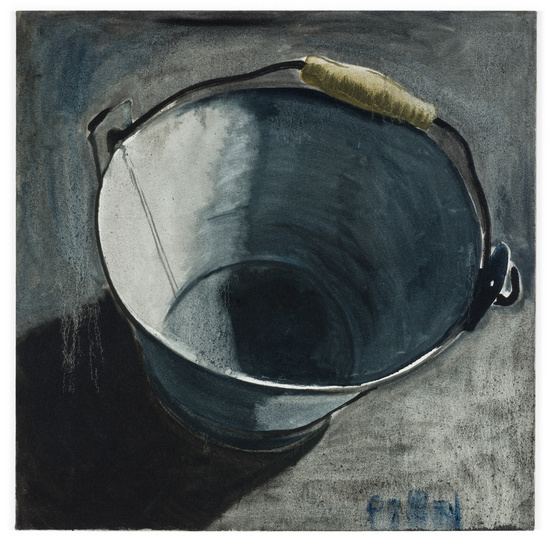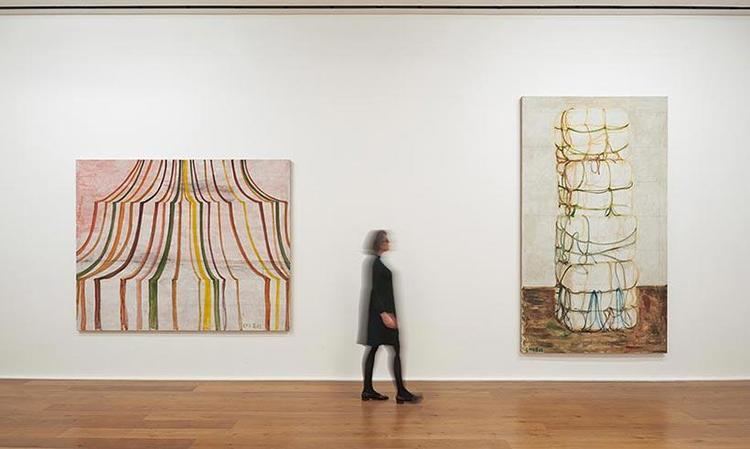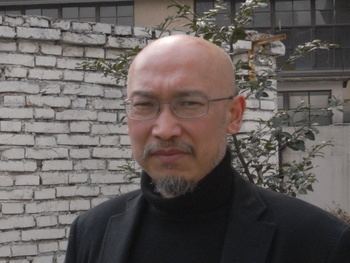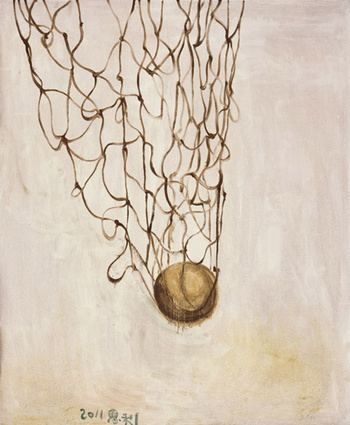Name Zhang Enli | ||
Zhang enli and the allure of the prosaic
Zhang Enli (simplified Chinese: 张恩利; traditional Chinese: 張恩利) was born 1965 in Jilin Province, China, is a professional artist living and working in Shanghai. He graduated from the Arts & Design Institute of Wuxi Technical University, China in 1989, and teaches at the Arts and Design Institute of Donghua University.
Contents
- Zhang enli and the allure of the prosaic
- Zhang enli installing the box at hauser wirth london
- Life
- Exhibitions
- Work
- Humans
- Containers
- Trees
- References

Zhang enli installing the box at hauser wirth london
Life

Zhang Enli’s work is heavily marked by the personal transition and move he made 20 years ago from the provincial town of Jilin in the north of China to Shanghai. By focusing on ordinary objects and the everyday in his work, the artist represents the contrast between the small city and the sprawling metropolis - between two differing states of mind and environment.

Unlike many of his Chinese contemporaries, Zhang Enli’s practice does not bear relation to consumer criticism, ‘Political Pop’, ‘Kitsch Art’, or ‘Cynical Realism’ that emerged from China during the art boom of their post-socialist society in the 1990s, but instead focuses on the familiar and often overlooked everyday objects and environments the artist encounters on a daily basis, viewed from a unique perspective.

His works are mostly composed in series, such as his paintings that focus on the idea of the container — namely cardboard boxes, ashtrays, tin chests, or lavatories. Other works depict functional municipal structures that fill the streets of Shanghai, such as public toilets and tiled outdoor water features. Choosing to focus on such seemingly banal and insignificant features, Zhang Enli does not make any grand statement to politics or immortality. He does not aim to form idealistic or metaphorical concepts or compensate unpleasant realities, making his work neither traditional, superficially critical, nor overly sentimental. Furthermore, he believes that ”contacts” and “public relations” do not constitute an essential part of creativity, but that only in isolation and silence, he can reflect, observe, and experience wherever his creativity leads him.
Exhibitions
Zhang Enli has participated in such dynamic group exhibitions as "Dreaming of the Dragon’s Nation: Contemporary Art from China’, at the Irish Museum of Modern Art, Dublin, in 2005, and "Infinite Painting and Global Realism", curated by Francesco Bonami and Sarah Cosulich Canarutto, at Villa Manin Centro d'Arte Contemporanea, Udine, in 2006, in addition to his solo show “Human, Too Human" at BizArt, Shanghai in 2004.
It was not until 2006, however, that he gained broad international attention when he attended Art Basel at which he was one of the most successful contemporary Chinese artists. Since then, Zhang Enli’s success has slowly infiltrated the international art world as a result of the continued positive reception of his work, and more recently due to solo shows in 2009, such as “Zhang Enli” at the Ikon Gallery in Birmingham, curated by Jonathan Watkins, and “Zhang Enli”, Kunsthalle Bern, Switzerland, curated by Philipe Pirotte.
In 2010, solo exhibitions of Zhang has been held at Mingsheng Contemporary Art Museum and at Hauser & Wirth London, who represents Zhang alongside the ShanghArt Gallery in Shanghai and Beijing. In the latter show, he presented new, sensational series of works that continue his quest to invest life into the most common of signifiers: from details of trees to lace curtains, bare mattresses, and rubber tubing.
Work
The development of the pivotal objects of his work.
Humans
In Zhang Enli’s paintings of the 1990s, humans were almost the only protagonists, especially those with negative character traits or flaws. He was thus labelled as an ‘expressionist’ artist which is, however, a contradiction to his practice, as the ‘labelling’ confines his work, its layers, and the complex aspects of his depicted objects.
Many of Zhang Enli’s earlier paintings show a person in discordant colors on coal-black backgrounds. Their dynamic vibrancy created by the over-lay of quick brushstrokes moving between straight lines and almost dancing curves evoke a strong impression, as though the subject is exploding with boiling emotions.
The artist has also been known to depict groups in familiar social situations. The activities Zhang Enli chooses to portray are usually that of popular Chinese pastimes, drinking and eating in particular, however underneath the surface, the paintings seem to be telling that these actions are demonstrative of social status rather than enjoyment. The subjects in Zhang Enli’s paintings are often isolated and disconnected to the world and their surroundings.
Although he uses oil and canvas, his way of painting has now become increasingly similar to traditional Chinese ink painting, where every brushstroke is visible, unchangeable, and a formative trait of the painting. This can be considered to be transferring the immobile isolation of the people imprisoned in their restricted point of view, into the painting. They seem unable to find, let alone to use, the silence to look beyond their daily routine in which not only objects but also people are too often reduced to their meaning, their content, and their value to others.
The artist’s paintings also show a great appreciation and reference to Zhang Enli’s other great interest: cinema and Rainer Werner Fassbinder in particular. In both artists’ works, there are secret truths, hidden dreams, and negative human traits revealed in their respective media. Furthermore, their subjects are only able to interact with others by abusing each other: the artists believe it is impossible to know others if one does not even know oneself.
Zhang Enli also often depicts himself in his paintings of others. By doing so, he shows himself as the voyeur, and it defines him as an observing subject participating in the world, his surroundings, and others.
Containers
Zhang Enli has stated, ‘I deal with reality in order to express something that goes beyond reality’ and as such he draws on the viewer’s desires for the simplest portrayal of existence and demonstrates that the pictorial, the psychological, the cultural, and the artistic are aspects of everything.
He shows that even he simplest thing has so many layers which only wait for viewers to un-centre themselves and take a further look into their surrounding world so as to understand that everything is complex and consists of more aspects than the obvious. However, he is not just imbuing subjects with new relevance taken from a human value system. Zhang Enli’s work reveals that nature, beauty, and even interactive play with the world are features that everyday objects possess in themselves. Everything is connected with each other, and in this process, the ordinary becomes uncommon.
Trees
Trees are rare subjects in Chinese contemporary paintings, and Zhang Enli adopts unconventional methods in which to portray them: in order to render the trees, he takes pictures of trees of close proximity, and in his studio, he paints parts of them with disciplined analytical attention, choosing to paint trunks with incomplete branches and foliage without trunks. However, these parts are not chosen for any symbolic purpose, but merely to show how they are, since there is beauty in all of them, not only in those that are believed to bear special grace and to allude to specific feelings or meanings.
The fluid traits that Zhang Enli used to outline the human figures imbue the trunks with energy, whilst the semi-transparent brushstrokes of the paintings are used to show the ephemeral character of the foliage. Painting with these thin washes of pigment, which often leaves traces of turpentine dripping down the canvas, he achieves a sophistication and richness that balances the simplicity of his technique and subject matter.
